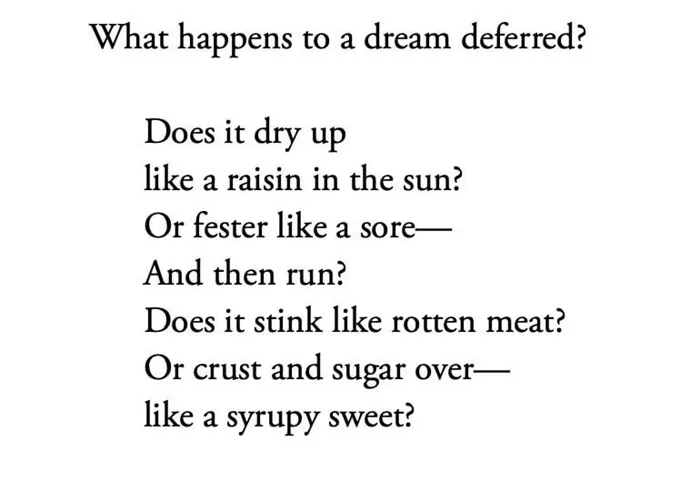Welcome to Poem of the Day – Harlem by Langston Hughes
Langston Hughes is one of the most influential poets of the Harlem Renaissance, and his poem “Harlem” stands as one of his most iconic works. Written in 1951, “Harlem,” often referred to by its first line, “What happens to a dream deferred?” is a powerful meditation on the struggles faced by African Americans in a society that continuously suppresses their dreams and aspirations. In this article, we will delve into the meaning and significance of the poem and explore the themes it addresses.
Harlem Poem
What happens to a dream deferred?
Does it dry up
like a raisin in the sun?
Or fester like a sore—
And then run?
Does it stink like rotten meat?
Or crust and sugar over—
like a syrupy sweet?
Maybe it just sags
like a heavy load.
Or does it explode?
Harlem Explanation
The Structure of the Poem
“Harlem” is a short, free-verse poem consisting of just six lines. Despite its brevity, the poem delivers a profound message. Hughes uses a series of rhetorical questions followed by striking, vivid imagery to explore the effects of unfulfilled dreams. Each line builds upon the last, leading to a powerful conclusion that leaves readers contemplating the consequences of deferring one’s dreams.
The Meaning of “Deferred Dreams”
The central question of the poem, “What happens to a dream deferred?” immediately draws attention to the idea of dreams being postponed or denied. The word “deferred” means to be delayed or postponed. Hughes is asking what happens when dreams—especially the dreams of African Americans for equality, freedom, and a better life—are continually put on hold. He suggests that these deferred dreams can have harmful, even destructive consequences.
Imagery in the Poem
In the following lines, Hughes presents a series of powerful images to answer his question about deferred dreams. Each image represents a different possibility for what might happen when dreams are left unfulfilled:
“Does it dry up / like a raisin in the sun?”
The first image compares a dream to a raisin drying up in the sun. This suggests that a dream that is ignored or postponed may lose its vitality, becoming shriveled and unrecognizable, much like a raisin. The image of something drying up in the sun evokes feelings of decay and stagnation.
“Or fester like a sore / and then run?”
The second image compares a dream to a wound that festers and eventually runs. This suggests that, when dreams are ignored, they can become painful, leading to deeper wounds that worsen over time. The image of festering evokes the idea of unresolved hurt and growing frustration.
“Does it stink like rotten meat?”
The third image compares a deferred dream to something that rots and stinks. This metaphor implies that a dream left unfulfilled can lead to a sense of decay and disgust. It evokes the idea that unaddressed dreams create an unpleasant and oppressive atmosphere.
“Or crust and sugar over / like a syrupy sweet?”
The fourth image presents a dream that has been covered up, perhaps by a sugary coating, implying that it may be hidden or ignored in a way that is outwardly pleasant but does not address the deeper problem. The image of sweetness contrasts with the earlier images of decay, suggesting that sometimes the consequences of deferred dreams are masked or made to seem acceptable, though they are still harmful in the long run.
“Maybe it just sags / like a heavy load.”
The final image compares a deferred dream to a heavy load that weighs one down. This evokes the sense of burden and oppression. A dream that is denied can cause emotional and psychological strain, making life difficult and heavy to bear.
The Message of the Poem
Through these vivid images, Langston Hughes illustrates the potential consequences of deferred dreams. The poem highlights the frustration and disillusionment that can arise when hopes and aspirations are continually put on hold, particularly in the context of the African American experience in the early 20th century.
At the time Hughes wrote this poem, African Americans were facing systemic racism and social inequality. The “dreams” he refers to are not just personal ambitions but also the collective aspirations of the Black community for freedom, equality, and justice. In the poem, Hughes reflects on how these dreams are often suppressed or ignored by society, leading to feelings of despair and anger.
The final line of the poem, though not explicitly stated, carries an implied question: “What happens when deferred dreams explode?” This suggests that there are serious consequences for ignoring or repressing dreams and desires. The explosion of these dreams could lead to social unrest, rebellion, or even violence.
Conclusion
Langston Hughes’ “Harlem” is a poignant reflection on the effects of deferred dreams, particularly in the context of racial injustice. Through its striking imagery and simple structure, the poem powerfully conveys the emotional and societal impact of unfulfilled aspirations. By asking what happens to dreams that are constantly delayed or denied, Hughes challenges readers to consider the consequences of ignoring the hopes and desires of marginalized communities. In this way, “Harlem” remains an enduring and relevant piece of literature that speaks to the struggles of the past and continues to resonate with contemporary readers.

